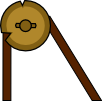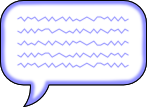Lesson 2
 Pulley
Pulley
We can see some interesting relationships by graphing the data we have collected.
Graph A
Use the number of supporting ropes and the length of rope used to lift our stone from Table 3 to complete graph A in your lab packet.
As the number of supporting ropes on the pulley increases what happens to the length of rope that must be pulled to lift the stone into place? Using this graph, predict the length of rope that would be pulled if you were using 5 supporting ropes.
Graph B
Use the force applied in each test and the length the force was pulled to complete graph B in your packet.
As the amount of force applied increases what happens to the length of rope pulled? Predict the force if the length of rope pulled had been 7 meters.
Graph C
Use the number of supporting ropes and the force applied to complete Graph C.
As the number of supporting ropes increases what happens to the amount force applied? Predict the force needed if 5 supporting ropes were used.
Was this prediction as easy to make as the predictions using graphs A and B? Explain your answer using complete sentences.

Talk Now - 2g
With your partner, compare the patterns formed by the points on each of the graphs. Using complete sentences describe the pattern of the graph and what that pattern tells you.



